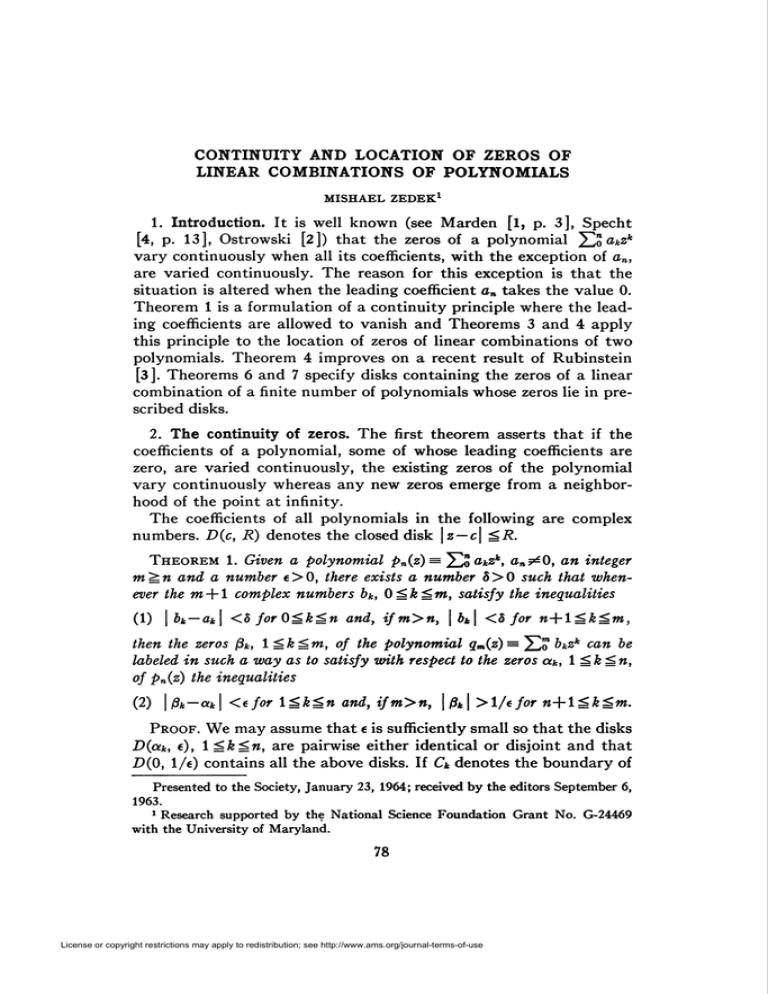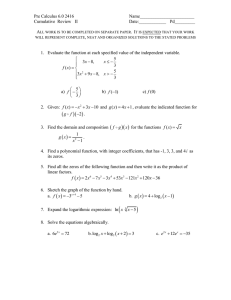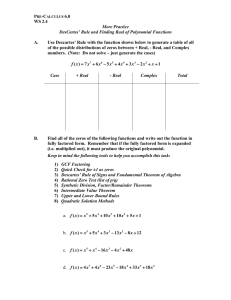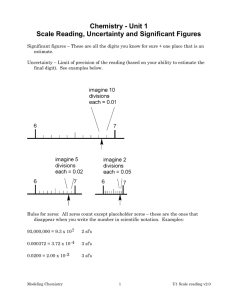Full-text PDF
advertisement

CONTINUITY AND LOCATION OF ZEROS OF LINEAR COMBINATIONS OF POLYNOMIALS MISHAEL zedek1 1. Introduction. It is well known (see Marden [l, p. 3], Specht [4, p. 13], Ostrowski [2]) that the zeros of a polynomial Yo a*z* vary continuously when all its coefficients, with the exception of an, are varied continuously. The reason for this exception is that the situation is altered when the leading coefficient an takes the value 0. Theorem 1 is a formulation of a continuity principle where the leading coefficients are allowed to vanish and Theorems 3 and 4 apply this principle to the location of zeros of linear combinations of two polynomials. Theorem 4 improves on a recent result of Rubinstein [3]. Theorems 6 and 7 specify disks containing the zeros of a linear combination of a finite number of polynomials whose zeros lie in pre- scribed disks. 2. The continuity of zeros. The first theorem asserts that if the coefficients of a polynomial, some of whose leading coefficients are zero, are varied continuously, the existing zeros of the polynomial vary continuously whereas any new zeros emerge from a neighbor- hood of the point at infinity. The coefficients of all polynomials in the following numbers. Die, R) denotes the closed disk \z —c\ ^R. are complex Theorem 1. Given a polynomial pniz) = YôakZk, an9^0, an integer m^n and a number «>0, there exists a number S>0 such that whenever the m-\-l complex numbers bk, O^k^m, satisfy the inequalities (1) I i* —a*I <8 forO^k^n and, ifm>n, \bk\ <S for n+l^k^m, then the zeros ßk, l^k^m, of the polynomial qmiz) = Yo °kZk can be labeled in such a way as to satisfy with respect to the zeros ak, l^k^n, of pni¿) the inequalities (2) \ßk-ak\ <efor l^k^n and, ifm>n, \ ßt\ >l/e for n+l^k^m. Proof. We may assume that e is sufficiently small so that the disks Diak, e), l^k^n, are pairwise either identical or disjoint and that £)(0, 1/e) contains all the above disks. If C* denotes the boundary of Presented to the Society, January 23, 1964; received by the editors September 6, 1963. 1 Research supported by the National Science Foundation with the University of Maryland. 78 License or copyright restrictions may apply to redistribution; see http://www.ams.org/journal-terms-of-use Grant No. G-24469 79 CONTINUITYAND LOCATIONOF ZEROS D(ak, e), l^k^n, and Co is the boundary of D(0, 1/e), then let M=min0<ikin(tninzeCk \pn(z)\)- Obviously 5(€m+ • • • +e + l) <Mem. If now the M>0. We pick 8 to satisfy bks satisfy the inequalities (1), we have for *€LÇ G, I?-(«) - #.(«) I ^ ÊI J*- *l 1*1* + Ê I»*l1*M£«(!/«)* <Jf. 0 Applying Rouché's n+l theorem 0 to qm(z) = pn(z) + \qm(z) —pn(z)] for each of the circles Ck, O^k^n, we deduce that each of the disks D(ak, e), l^kf^n, contains as many pYs as ak's, thus implying the first part of (2), and that the disk D(0, 1/e) contains precisely n zeros of qm(z), which proves the second part of (2). 3. Linear combinations of two polynomials. Our purpose is to study the location of the zeros of the polynomial in z F(z, \)=pm(z) +~kqn(z) when it is known that the zeros of the polynomials pm(z) and qn(z) are, respectively, in the disks D(ci, Ri) and D(c2, R2) and X is a constant. The special case m = n was studied by Walsh [5]. We shall therefore assume for the moment m^n and return to the special case in §4. We first quote a theorem of Walsh [S]: Theorem 2. If the points «i, a2, • ■ • ,an lie in the closed disk D(c, r), the equation in a (z - ai)(z — a2) ■ ■ • (z - an) = (z — a)n has at least one root in D(c, r). Next we prove a theorem polynomials : about a special linear combination of Theorem 3. For a fixed X, let G(z, X) = (z — ai)m + X(z — a2)n, where m and n are arbitrary positive integers, m > n ^ 1. Let K = mm | a2—ai | m-"/nn (m — n) m~n. I. If ri is the unique2 positive root of the equation (3) A(*)mx»- |X|(*+ \a,-ai\)»~0, then the m zeros of G(z, X) lie in the disk D(ai, ri). II. If |X| >K, let r2, r3 be the two3 positive roots of the equation (4) B(x) = | X | as»- (x + | a2 - «i | )n = 0. 1 By Descartes' rule of signs and ^4(0)<0, A( m )>0. * Since 5(0) <0, B( «>) <0, by Descartes' rule of signs there are at most two positive roots. We note that 5(y)è0 is equivalent to |x| è(y+| ora—«i| )m/y=R(y) and that K = m\n[R(y), 0<yj. License or copyright restrictions may apply to redistribution; see http://www.ams.org/journal-terms-of-use 80 MISHAELZEDEK [February Then Diai, rt) contains exactly n zeros of Giz, X) while the annulus r2 < | z | < r8 contains none. III. If |X| =K, let r2 be the unique positive idouble) root of (4). Then at least n zeros of Giz, X) lie in Diai, r2), and at most n zeros lie in its interior. Remark. It is easy to see that if for some yi > 0 we have A (yi) > 0, then ri<ji and if for some y2>0 we have 5(y2)>0, then r2<y2<r3. Therefore ri and r2 can be replaced by yi and y2, respectively, in Parts I and II of Theorem 3. This would result in a weaker but more convenient proposition. Proof. I. The m zeros of Giz, 0) are all located at ai. According to Theorem 1, as we vary the values of the parameter continuously from 0 to X, the same number of zeros of Giz, X) will lie in a disk Diai, y), y > 0, unless at least one of the zeros, say z', has crossed the boundary \z —ai\ =y for some value X' of the parameter. But for such X' we have the inequality (z' — ai)m\ (5) |X'| = (z'-«2)"l ym iy + | a2 - ai | )n Therefore if, for a fixed y, X satisfies the opposite inequality (6) y - I a I (y + | «2 - «i | )n > 0, smaller values of X will also satisfy (6) and thus the m zeros of Giz, X) are in the interior of Diai, y). Part I of our theorem follows from the observation that y>n implies (6). II. Set p = 1/X and Hiz, X) s G(z, X)/X = (z - a2) " +piz - ax) ». Again we observe that the n zeros of Hiz, 0) are all at «2- By Theorem 1, for sufficiently small values of p, the disk Dia2, y), y>0, would still contain exactly n zeros of Hiz, p), the remaining m —n zeros lying in a neighborhood of <x>.If for some value p' of the parameter, a zero, say z', of Hiz, p) is on the boundary of Z)(a2, y), we would have (7) Therefore, (8) (z' - U'| a2)n (z' - oti)" iy + I «2 —ai | )" if for a fixed value of y, p satisfies the opposite inequality yn- \p\iy+ |a2-ai|)m>0, smaller values of p will also satisfy (8), and thus Dia2, y) will contain precisely n zeros of Hiz, p), hence of G (z, X). Inequality (8) can be rewritten as Biy) > 0 and it is seen easily that ra <y <r» implies Biy) > 0 and Part II follows immediately. License or copyright restrictions may apply to redistribution; see http://www.ams.org/journal-terms-of-use 81 CONTINUITY AND LOCATION OF ZEROS 1965] III. If |Xl =K, B(r2)=0 but for 0<y^r2, B(y)<0. However, if |X| >K (or fju| <1/K) we have r2 — I ß I (r2+ I a2 —o-iI ) > 0 which indicates that as the absolute value of the parameter grows from 0 to 1/K, the n zeros of H(z, 0) remain inside D(a2, r2) and the additional m —n zeros, which appear when ß^O, remain outside D(a2, r2). Only when | ju| reaches the value 1/K can some of the zeros of either group actually lie on the boundary of D(a2, r2). This completes the proof of Theorem 3. We now come to the main result of this section : Theorem 4. Let fm(z)=zm+am-izm~1 + ■ ■ ■ +a0 and g„(z)=zn -r-&„_izn-1-f- • ■ • +bo be two polynomials whose zeros lie, respectively, in the disks D(cu Ri) and D(c2, R2) and suppose m>n^l. For a fixed \let F(z,\)=fm(z)+\gn(z). Then: I. If pi is the unique positive root of the equation (9) C(x) mar- \\\(x+ \ct-ci\ +Ri + R2)n = 0, then the m zeros of F(z, X) lie in D(ci, Ri+pi). II. Setting (10) L = mm(\c2 —Ci\ +Ri+R2)m/nn(m D(x) m I XI *» - (x + \c2- — n)m~n, the equation ci\ + Ri + R2)m= 0 has two positive roots p2, p3 (p2^pi), provided |X| ^L. At least n zeros of F(z, X) lie in D(c2, R2+p2). Remark. weakened Again, as in Theorem but made more practical 3, the above statements can be by replacing the disks D(cx, Ri+pi) and D(c2, R2+p2) by the disks D(c%, Ri+yi) and D(c2, R2+y2), where yi and y2 satisfy the inequalities C(yi) >0 and D(y2) >0. Proof. It follows from Theorem 2 that the zeros of F(z, X) are identical with the zeros of G(z, \) = (z—ai)m+\(z—a2)n, where ai and a2 are fixed, though undetermined, points in the disks D(ai, Ri) and 2?(a2, R2), respectively. If we compare the equations (3) and (9) we see that since |a2—ai| ^ | c2—Cj| +Ri+R2t we have fitSpi. Similarly, comparing (4) with (10), we have r2-^p2^pi^ri. To conclude the proof it is sufficient to refer to Theorem 3 and to note that D(au ri) ED(cu Ri+pi) and D(a2, r2) ED(c2, R2+pi) regardless of the exact location of ai and a2. 4. Linear combinations of several earlier, the case m = n was studied polynomials. by Walsh As mentioned [5] who obtained following result: License or copyright restrictions may apply to redistribution; see http://www.ams.org/journal-terms-of-use the 82 mishael Theorem zedek [February 5. With the notations of Theorem 4,ifm of F(z, X) =/n(z) +^gniz), = n, then the zeros X?* 1, are in the union of the disks /* - (-X)»*»c, Ri+ \\\1"RI\ \ i-(_x)>/» ' |i_(_x)i/n|J' where (—X)1/Btakes all possible values. Any one of these n disks which is external to all others contains precisely one zero. The methods used in §3 yield the following result which is also a corollary to Theorem 5 inasmuch as the disk in the corollary contains the n disks in the theorem : Corollary. With the notations of Theorem i,ifm = n and if | X| < 1, the zeros of Fiz, X) =/„(z)+Xg„(z) lie in the disk P(ci, i?i+pi), where Pi is the unique positive root of the equation (11) *» - | X| (* + | to - ci\ +Ri + Ri)" = 0, that is, |x|"»(|g,-(*| (12) Pl =-1-|X|»- +R! + Ri) Before turning to linear combinations of several polynomials of the same degree n, we establish a lemma which is of some interest in its own right: Lemma. Given the k (^2) nonzero arbitrary Xi, • • • , Xt which are subject to the conditions : complex numbers I. IXil^lXyl whenever i9aj. II. The sum of any number among the X's is never 0, we can always relabel the X's so that Ix*| < |X*_,+ • • - + Xi|, |X*_i| < |a*_2+ • • - + Xi|, • • -, |Xi| < ¡Xi + X»|, |Xi| < |Xi|. Proof. The case k = 2 is trivial. Suppose then that k ^ 3 and that the lemma is valid for 2, • • • , A—1 complex numbers satisfying Conditions I and II. To prove our lemma by induction, it suffices to show that among the k numbers there is one, say X*, which satisfies |Xt| <|X*-i+ • • • +Xi|. (The remaining inequalities in (13) will hold true by the assumption |X<| ^ | S—X¿| for l^i^k, A inequalities in the induction.) Indeed, otherwise, if where S= Y* ^«>squaring and adding the we would have £* |X<|2^£ï |5-X<|2 - Zî (X<5+X,-5) = (A-2) | S\2, which is false. License or copyright restrictions may apply to redistribution; see http://www.ams.org/journal-terms-of-use or 0^A|s|2 83 CONTINUITY AND LOCATION OF ZEROS 1965] Theorem 6. Let fi(z)=zn+an%zn~l+ ■ ■ ■ +af, lat'S*. be k^2 polynomials of the same degree n whose zeros lie in the disks D(cit Ri), respectively. Let F(z; Xi, • • • , X*)=Xi/i(z) + • • • +\kfk(z), where the \i's are complex numbers satisfying Conditions I and II in the lemma and thus will be assumed to satisfy also the inequalities (13). Then the n zeros of F(z; Xi, • • • , X*) are in the disk D(ch Ri+ 2^í_1 P¿) where the pis are determined recursively as follows: po = 0, and for l^i ^k —1, Pi is the unique positive root of the equation (14) x"- Xí+1 / ¿xJ (x+ ICi+i-ciI -f-Ai+A.+x-f £PiY=0. Proof. The case k = 2 follows from the corollary to Theorem 5. We proceed with the proof by induction. Suppose our theorem holds true for a linear combination of k —1 polynomials. Then the zeros of F(z; Xi, • • • , X*_i) are in D(d, Ri+ 2Z*~2P«) where the p<'s are determined again by (14). But F(z; Xi, • • • , Xi-i, X*)= F(z; Xi, • • • , X*_i)+ \kfk(z) = (Xi + • • • + X*_i)g*_i(z)+ \kfk(z), where gk-i(z)=zn+ • • • is a polynomial of degree n. Applying the corollary to the last linear combination of two polynomials of equal degree gives us D(cy Ri+ 23î_1 P<) as a disk containing the zeros of F(z; Xi, • • • , X*). Theorem 6 permits us, except in some special cases, to replace by a single polynomial any group of polynomials of the same degree that appears in a linear combination of several polynomials. We shall therefore assume in our final theorem that the polynomials under consideration have distinct degrees: Theorem 7. Let fi(z)=z»i+ani)._izn<-1+ • • • +af, l^iúk, k^2, be k polynomials whose zeros lie in the disks D(cit Ri), respectively. Suppose ni<n2< ■ ■ ■ <nk. Let F(z; Xi, • ■ • , X*)= 23í^»/¿(z)> where the \i,s are arbitrary nonzero complex numbers. Then the nk zeros of F(z;\i, • • • , Xt) lie in the disk D(ck, Rk+pi), where pk is determined recursively as follows: pi = 0, and for 2^i^k, p.- is the unique positive root of the equation (15) Ai(x)= x»<- I Xí-lA.-I (x+ I a-Ci-i I +Ri+Ri_1+Pi-i)x»>-1 = 0. Remark. A remark similar to the ones made following Theorems 3 and 4 can be made here : in the statement of Theorem 7 the roots p¿ could be replaced by numbers y,>0 for which ¿4j(y,)>0. License or copyright restrictions may apply to redistribution; see http://www.ams.org/journal-terms-of-use 84 D. G. DICKSON Proof. If we define the polynomials hiz)=fiiz), and for 2^i^A, [February A¿(z) recursively as follows: A¿(z)=/¿(z) + (X,_i/Xj)A,_i(z), we see that Fiz; Xi, • • • , X*)=XfcA*(z). Thus A¿(z) is a linear combination of two polynomials to which Theorem 4 is applicable and the truth of Theorem 6 follows by induction. References 1. M. Marden, The geometry of the zeros of a polynomial in a complex variable, Math. Surveys No. 3, Amer. Math. Soc., Providence, R. I., f949. 2. A. Ostrowski, Recherches sur la méthode de Graeffe et les zéros des polynômes et des séries de Laurent, Acta Math. 72 (1940), 99-257. 3. Z. Rubinstein, Analytic methods in the study of zeros of polynomials, Pacific J. Math. 13 (1963), 237-249. 4. W. Specht, Algebraische Gleichungen mit reden oder komplexen Koeffizienten, Enzyklop. d. math. Wissen., 2nd ed., I 1, 3, II, Stuttgart, 1958. 5. J. L. Walsh, On the location of roots of certain types of polynomials, Trans. Amer. Math. Soc. 24 (1922), 163-180. University of Maryland ZEROS OF EXPONENTIAL SUMS1 D. G. DICKSON 1. Introduction. This paper deals with the distribution in the complex plane of the zeros of an exponential sum of the form (i) m = è Ajg-ii+ tM\*-<; )=i where n> 1 ; the Aj and the », are complex numbers such that A,¿¿0 and the w, are distinct; the m¡ are non-negative integers; the functions €j are analytic for \z\ ^r0^0 with lim,,«, €y(z) = 0. A function of the form (2) Ê P,(i)«»", j-i Received by the editors September 9, 1963. 1 This work was supported by a grant Irom the National License or copyright restrictions may apply to redistribution; see http://www.ams.org/journal-terms-of-use Science Foundation.





